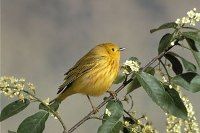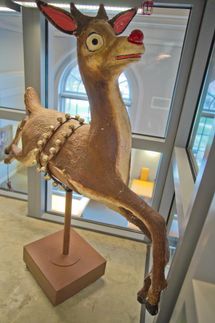Forest songsters evolved in an early burst of innovation
Evolution seems to have happened in fits and starts -- at least that's what the fossil record shows. From trilobites to pterodactyls, ammonites to Archaeopteryx, scientists find the same pattern: brief bursts of innovation in which a single species or branch on the tree of life turns into a cluster of new twigs, then lapses into long stretches ruled by the status quo.

A yellow warbler
Courtesy Mike Hopiak
The question is why. Is the fossil record incomplete -- are fossil beds just snapshots of a process that occurs at a steady pace throughout time? Or might changing environmental or geologic conditions alter the rate at which species arise?
"It's arguably one of the most fundamental questions in all of evolutionary biology," said Dan Rabosky, a graduate student at the Cornell Laboratory of Ornithology and lead author of a new analysis of the problem, published online July 9 in the journal Proceedings of the Royal Society B. "How do species arise? Where does all this biodiversity that we see on Earth come from?"
Rabosky and co-author Irby Lovette, director of the Fuller Evolutionary Biology Program at the Lab of Ornithology, used DNA analyses to look at 5 million years of evolution in 25 species of colorful North American songbirds known as wood warblers. They discovered that a flurry of species divergence occurred early on, with many species appearing in just the first million years.
Rabosky and Lovette developed a new mathematical model that attributed the pattern to the way closely related species divide up their environment. At first, with few relatives around to compete with, species can differentiate rapidly. But as the species list grows, competition becomes fiercer and leads to fewer opportunities for additions.
"Right after the dinosaurs went extinct, most people are aware that there was a huge explosion of mammal diversity," Rabosky said. "That extinction created lots of ecological 'space' -- opportunities for new species of mammals to take advantage of resources. On a much smaller scale of both space and time, this little group of warblers from North America might be playing out the same story."
The pattern of rapid diversification is well known to biologists -- they've even coined a name for the process: "adaptive radiation." But the best-known examples tend to involve geographic isolation: Darwin's finches of the Galapagos, anole lizards of the Caribbean and the marvelously colorful cichlid fishes of Africa's inland lakes.
"What's interesting is that this happened on a continent where it's ecologically much more complex than an island," Rabosky said. "You've got lots of competitors. Clearly, lots of other birds were already here, eating insects and probably doing what warblers do now."
Rabosky and Lovette chose to study the warbler genus Dendroica and to use DNA analyses because they needed a detailed picture of the genetic relationships among the 25 species -- a level of information that fossils simply can't provide. Those details let them reconstruct, species by species, the chronological order in which new species appeared.
And besides, 4-inch-long, half-ounce forest birds don't leave much of a fossil record.
"In fact," Rabosky said, "the vast majority of biodiversity on this planet that we need to explain doesn't have a fossil record. But just by using species that are alive today and looking at their DNA, we can see the signal of an early explosion of species millions of years ago."
Most read news
Other news from the department science

Get the life science industry in your inbox
By submitting this form you agree that LUMITOS AG will send you the newsletter(s) selected above by email. Your data will not be passed on to third parties. Your data will be stored and processed in accordance with our data protection regulations. LUMITOS may contact you by email for the purpose of advertising or market and opinion surveys. You can revoke your consent at any time without giving reasons to LUMITOS AG, Ernst-Augustin-Str. 2, 12489 Berlin, Germany or by e-mail at revoke@lumitos.com with effect for the future. In addition, each email contains a link to unsubscribe from the corresponding newsletter.
Most read news
More news from our other portals
Last viewed contents
Noctiluca_scintillans

How plants protect photosynthesis from oxygen
Immunolabeling
Glasgow_Coma_Scale
Antidiarrhoeal
Neurofibromatosis_type_II
Dysphagia
Homeobox























































